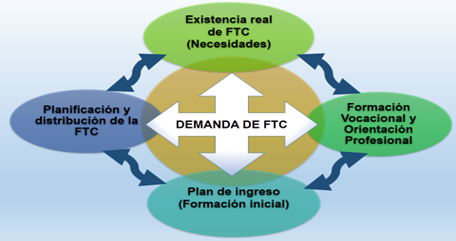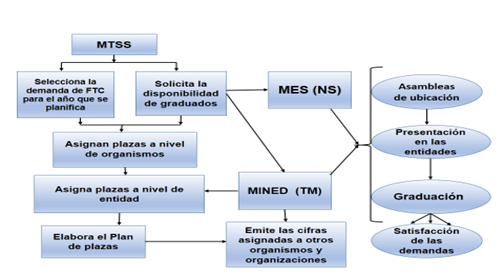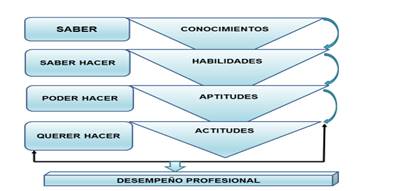Mi SciELO
Servicios Personalizados
Articulo
Indicadores
-
 Citado por SciELO
Citado por SciELO
Links relacionados
-
 Similares en
SciELO
Similares en
SciELO
Compartir
EduSol
versión On-line ISSN 1729-8091
EduSol vol.23 no.85 Guantánamo oct.-dic. 2023 Epub 05-Oct-2023
Original article
The management of the qualified work force: an approach to its main components
1 Ministerio de Educación de la República de Cuba.
The production of material goods, service activities and others aimed at social development, need to guarantee human resources, fundamentally, the qualified labor force. From the integral vision, this investigation deepens on the insufficiencies presents in its mangement and in the educational sector. In order to improve it, a methodological strategy is proposed to help achieve the essential objective. The use of quantitative and qualitative methods and techniques allow an approach to its main components and the relationship established between them, which ensure the quality of the results.
Key words: Human resources; Skilled workforce; Efficiency; Demand process Management
Introduction
The research topics addressed in the educational sector are generally related to particular didactics, with the development of processes at the educational levels, pedagogy, psychology, vocational training and professional orientation, school and environmental health, among others. This paper addresses one without which it would not be possible to achieve the objectives proposed in the sector, since it is its main premise: human resources.
In the Ministry of Education, monitoring the management of its human resources, especially the management of the skilled labor force (GFTC below) has become a priority, given the current social, economic and financial complexities, as well as the transformations that are proposed and carried out.
At different moments of the planning system, aspects related to its completion, labor fluctuation, wages, the growing concern for the constant improvement of working conditions, attention to the health and safety of workers, the timely use of advances and introduction of the results of scientific and technological research are analyzed. All this leads to the construction of possible solutions that result in greater contributions and concrete results, in quantitative and qualitative terms. Other determinants and situations that influence the social order are present in the GFTC.
According to Cribeiro (2014) other influences are given by "...progressive future shortage of labor force, derived from the accelerated process of population aging" (p.2), this manifestation causes the decrease of the working age population, who produce the necessary material goods.
Further on Cribeiro (2014) refers to "...the low rates of entry and efficiency in higher education, which influences the satisfaction of the demands for skilled labor force of higher level made by the agencies (p.2).
The skilled labor force close to retirement age, which cannot be replaced by graduates of training centers.
Guilarte (2021) is of the opinion that "...the relationship that is generated today, in negative terms, between people entering employment and those leaving, a matter that is recognized in the rigorous statistics" (p. 5).
And no less important is the issue of migration in the last stage.
In GFTC, where the human being is the central axis, and is so in any organization, there is still a long way to go. From the perspective of the problematic situation presented, the existing contradiction between the inadequacies in the management performed and the level of satisfaction of the needs of qualified labor force demanded by the educational institutions was identified. Marx and Engels (1984) conceive that, "...the demand for men necessarily regulates the production of men..." (p. 9).
From this problematic situation, it is evident as a scientific problem how to contribute to the improvement of the GFTC in the educational sector and the objective is aimed at basing a methodological strategy for its improvement in the sector, from the planning system, ratifying the idea of Cribeiro (2011) where he emphasizes that, "...to sustain the contribution of the skilled labor force, it is necessary to correct distortions in the training process, allocation and use of the labor force, seen as a system" (p.17).
The objective of this paper is to socialize the fundamental components that were identified during the research, which are integrated in the management process with multiple agents and processes, which determine its results and are characterized according to the context, aimed at guaranteeing the educational process to comply with the state mandate.
Development
The educational sector has been faced with the need to apply multiple alternatives to cover the deficit of skilled labor force (FTC) needed for the processes to be developed in educational institutions, therefore, the management to be carried out must respond to such demands.
The documentary study allowed revealing that the term management was approached by different authors, among them stand out: Drucker (1954); Chiavenato (2007); Manrique (2016); Escudero et al., (2017) and Westreicher (2020). In practice, different meanings are identified, but they present common elements that relate them as: participatory action, ability to achieve what is proposed, execute actions and making use of technical and human resources, set of procedures and actions that are carried out to achieve a certain objective, allow the integration of all the actors of the institution, from a participatory perspective and aimed at making appropriate and timely decisions.
Similarly, it was shown that there are several authors who have addressed the workforce. The references show that the term has evolved until it currently refers to human talent. Among other authors, Odriozola (2007) considers that the concepts workforce and human capital are closely related in that they give a value to the knowledge and skills of human beings made available for the production of goods and services to society (p. 4).
We agree with the criteria of this author because they are considered more general, since they include values, at the service of society. The empirical methods and techniques applied allowed the characterization of the initial state of TQM in the educational sector, by verifying the behavior of the indicators and dimensions through the instruments applied to the sample, which revealed insufficiencies in the management carried out.
For the National Education System, the skilled labor force is considered to be that which possesses the training and knowledge that ensure the fulfillment of specific and common functions at the local, regional and national levels, in accordance with the State's mandate. Based on the systematization carried out, it is assumed that the GFTC is a set of actions that are carried out taking into account the demands made from its actual existence, the projection of initial training, the planning and distribution of graduates, which ensure the fulfillment of the specific and common functions defined for Education.
In line with the above, Cribeiro (2011) refers that "...it is necessary to better reconcile the global vision of workforce training; with the local vision that internalizes the specific needs of the territories" (p.17).
Therefore, it is considered that, in the educational sector, the demand process is the fundamental means of acquisition of the GFTC, which should be prioritized and given special attention. Its main components are shown in Figure 1.
An approach to its main components.
In practice, the components identified or manifested during the GFTC maintain a close relationship, subordination or dependence and linkage. The results of one of them depend to a great extent on the fulfillment or manifestation of the rest. Other components can be identified, but the following are the ones we will focus on in more detail:
Identification of the needs derived from the fluctuation of the TCF: it is determined by the increase of investments, which causes the increase of vacancies or in the case of the educational sector, the most common is the level of activity, translated into the enrollments of each educational level. At the same time the movements caused by internal transfers and transfers outside the sector, deaths, retirements, promotions to political and mass organizations, as well as inactivity caused by medical certificates and social and economic benefits with a high % that generate the use of various alternatives are analyzed.
Vocational training and professional orientation: a process based on the implementation and compliance with Decree Law 364 of 2019 and Resolution 289 of 2020 of the Ministry of Education. Its fundamental basis is constituted by the needs identified in each entity; based on them, the entire process is designed and the governing bodies of the specialties needed participate actively. The Council of Ministers, (2019) stated that:
The process of vocational training and vocational guidance is an essential element of the training of learners at all levels of education. It is carried out through the activities that take place before and during vocational training and in preparation for employment, both in educational institutions, including the pioneer palaces, and in the productive or service entities. (p. 3)
The efficiency in the results of Vocational Training and Professional Orientation (FVOP) is evidenced by the fulfillment of the initial training entry plans.
Entry plan. Initial training is determined by the demand for qualified labor force, and is the fundamental element for the projection of the entrance and labor placement of the graduates of the different levels of training. In the current conditions, this process is of great importance in the country, due to the economic and social transformations it is undergoing, where it is necessary to guarantee the satisfaction of labor force needs, prioritizing the most necessary specialties, gradually promoting their satisfaction. This component includes the follow-up of the efficiency indicators of the training centers.
Distribution of the skilled workforce: Resolution No. 8 of 2013 of the Ministry of Labor and Social Security, establishes the regulation on the planning of the training and distribution of the skilled workforce, which institutes the responsibility of agencies, national entities and Administration Councils in this process. The distribution must be executed in correspondence with the demands for skilled workforce made, to meet the identified needs and work systematically in the care and retention of the force assigned to the entity or organization. (See figure 2).
In this distribution process, the Ministry of Education is responsible for assigning the graduates of careers and pedagogical specialties, in correspondence with the demands made. In addition, the early assignment of graduates to their future job placement is organized, in compliance with the agreements of the IX Congress of the Federation of University Students.
This early placement has some advantages, among them, to identify leaders and reserves of cadres, to carry out the exercise of completion of studies according to the problems of the educational institution, to promote relations between the training center and the future graduate, in terms of the sense of belonging, labor identity and greater satisfaction in their performance. It also allows the development of Knowing, Knowing how to do, Being able to do and wanting to do, with optimal results in professional performance (See figure 3).
Other elements to be taken into account in the distribution are: the positions or occupations whose performance requires compliance with general or specific standards of conduct; as well as the selection of positions by designation because certain personal characteristics are required; in addition to complying with the Cadre Policy in its entirety.
Some results obtained in the research.
From theory and practice, the concept of GFTC is defined for the sector, the identification of its fundamental components, as well as the close relationship between them and the possibilities it offers to anticipate the changes that may occur in the educational institutions and in the system in general.
Priority is given to the attention and follow-up of FTC training, fundamentally teacher training, the behavior of admission and the efficiency indicators of the training centers; in correspondence with this, the satisfaction of the demands that are made.
Conclusions
The formation of the FTC is a need that requires the integral attention of its fundamental components, the participation of all the factors and the channeling of common efforts to approach the satisfaction of the demands, according to the identified needs. These should not be carried out depending on the moment, but on the strategic projection.
There are enough reasons why new ideas are needed related to the management and attention to human resources, to their FTC, their demand, their rational and optimal use, in order to guarantee the fulfillment of the objectives, mainly in the educational sector, due to its state mandate.
Referencias bibliográficas
Consejo de Ministros. (2019). Decreto No. 364. De la formación y desarrollo de la fuerza de trabajo calificada (GOC-2020-107-O10). La Habana: Consejo de Ministros. [ Links ]
Chiavenato, I. (2007). Administración de Recursos Humanos. El capital humano en las organizaciones. (8va ed.) México: McGraw-Hill. https://bit.ly/2N8BNoS pp 1. [ Links ]
Cribeiro, Y. (2011). Contribución de la fuerza de trabajo calificada al crecimiento económico en Cuba. Principales determinantes. (Tesis doctoral). Universidad de la Habana. Cuba. [ Links ]
Cribeiro, Y. (2014). Fuerza de trabajo calificada en Cuba. https://dialogardialogar.wordpress.com/2014/10/28/fuerza-de-trabajo-calificada-en-cuba/ [ Links ]
Drucker, P. (1954). La práctica del Management. Pensamiento estratégico. https://www.marianoramosmejia.com.ar/lagestión -por-objetivos. [ Links ]
Escudero, M. et al, (2017). Curso 34 de Pedagogía. La gestión educativa.. Pueblo y Educación. [ Links ]
Guilarte, U. (2021). Un ministerio en el corazón de los cambios. Granma, 6 de marzo. La Habana. [ Links ]
Manrique, A. (2016). Gestión y diseño: Pensamiento y gestión. Convergencia disciplinar, N° 40 ISSN: 1657-6276. http://dx.doi.org/10.14482/pege.40.8808 [ Links ]
Marx, K. y Engels, F. (1984). Biblioteca de autores socialistas. Manuscritos económicos y filosóficos. La Habana: Ciencias Sociales. [ Links ]
Ministerio de Educación. (2020). Resolución No. 289: Reglamento de la responsabilidad de las entidades en la formación y desarrollo de la fuerza de trabajo calificada en el nivel medio (GOC -2020-108-O10). La Habana: Pueblo y Educación. [ Links ]
Ministerio de Trabajo y Seguridad Social. (2013). Resolución Ministerial No 8/2013. Reglamento sobre la planificación de la formación y distribución de la Fuerza de Trabajo Califica. La Habana. [ Links ]
Odriozola, S. (2007). Hacia una nueva concepción del llamado Capital Humano en Cuba. (Tesis doctoral). Universidad de la Habana. Cuba. [ Links ]
Westreicher, G. (2020). Qué es, definición y concepto.https://Economipedia.com. [ Links ]
Received: March 12, 2023; Revised: May 10, 2023; Accepted: July 08, 2023











 texto en
texto en 





